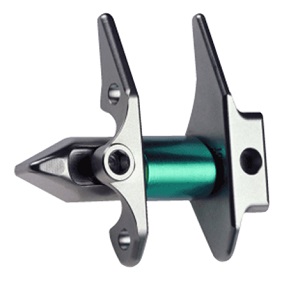What is the X-STOP Spacer?
The X-STOP Spacer is the only interspinous spacer approved by the FDA in the United States to treat the symptoms of lumbar spinal stenosis (LSS). LSS is the most common reason for back surgery in people aged 65 years and older in the United States.1 An estimated 6 million Americans suffer from LSS, with approximately 1.4 million being diagnosed annually.2
Approximately half of the patients who received the X-STOP Spacer in a two-year research study experienced a degree of pain relief and ability to increase their activity levels that was sufficient to be considered a successful outcome at two years after the surgery.3 The clinical benefit beyond two years has not been measured.
Am I an Appropriate Candidate for the X-STOP System?
The X-STOP System is indicated for patients aged 50 or older who have LSS. A diagnosis of LSS should be confirmed by a doctor with X-ray, MRI or CT scans. The X-STOP System is indicated for patients with moderately impaired ability to function, who experience relief from their pain symptoms when bending forward. Patients receiving the X-STOP Spacer should have already been under a doctor’s care and getting nonsurgical treatment for their symptoms for at least 6 months. The X-STOP Spacer may be implanted at one or two levels of the lumbar spine.
The X-STOP System should not be used if you have:
- an allergy to titanium or titanium alloy
- spinal anatomy that would prevent implantation of the device or cause the device to be unstable in your body
- cauda equina syndrome, which is a spinal nerve compression that causes bowel or bladder dysfunction
- bone fractures or a diagnosis of severe osteoporosis
- an infection in your blood or anywhere near your lower back where the surgery is planned.

How is the X-STOP Spacer Procedure performed?
During a surgical procedure that is less invasive than traditional open back surgery, the X-STOP Spacer is implanted between two bones in the back of the spine called the spinous processes-at the level of the pinched nerve. These spinous processes can be felt when you run your fingers down your spine. Ligaments in the spine, which are bands of tissue linking two bones, may help to keep the spacer in the desired location. By “unpinching” the nerve, the X-STOP Spacer may relieve the kinds of pain and discomfort caused by LSS:
- dull or aching back
- pain spreading to your legs
- numbness and “pins and needles” in your legs, calves or buttocks
- weakness, or a loss of balance, and
- a decreased endurance for physical activities
How long will it take me to recover?
The procedure to insert the X-STOP Spacer typically takes 45 to 90 minutes. Pain relief may be rapid. In fact, many people are up walking the very next day. The X-STOP Spacer procedure offers several benefits compared to traditional surgery for LSS, including:
- the option of local anesthesia
- the potential to be an outpatient procedure
- usually no removal of bone or soft tissue allowing for potentially quicker recovery
- fully reversible procedure that does not limit any future non-surgical and surgical treatment options
Are there any potential risks or complications?
Spinal surgery is not without risk. Specific information on the rates of complications for the X-STOP System and spinal surgery should be discussed with your doctor.
Complications that may be associated with X-STOP Spacer surgery include, but are not limited to, the following:
- implant dislodgement (movement out of place)
- implant not positioned correctly
- fracture of the spinous process
- foreign body reaction (ex. allergic reaction)
- additional surgery, which could include removal of the X-STOP implant
- mechanical failure of the implant.
Complications related to any type of surgery may include, but are not limited to, the following:
- reactions to anesthesia
- heart attack
- infection, which could require medication or an operation
- blood vessel damage/bleeding
- bruising (hematoma)
- pneumonia
- blood clots
- wound closure problems
- spinal cord or nerve damage
- pain or discomfort
- paralysis
- stroke
- death
Please consult your doctor about the complication rates related to surgery.
For additional product information, please visit www.xstopspacer.com or contact:
MEDTRONIC
Spinal and Biologics Business
1221 Crossman Avenue
Sunnyvale, CA 94089 USA
Customer Service: (866) 959-7466
MEDTRONIC
Spinal and Biologics Business
2600 Sofamor Danek Drive
Memphis, TN 38132 USA
1. Ciol MA, Deyo RA, Howell E, Kreif S. An assessment of surgery for spinal stenosis; time trends, geographic variations, complications and reoperations. J Am Geriatr Soc 1996:44:285-90.
2. US Census data and “Prevalence of Symptoms of Cervical and Lumbar Stenosis Among Participants in the Osteoporotic Fractures in Men Study” (Vogt, et al) SPINE 2006 Vol.31, Num 13, pp. 1445 – 1451
3. Zucherman JF, Hsu KY, Hartjen CA, Mehalic TF, Implicito DA, Martin MJ, Johnson DR 2nd, Skidmore GA, Vessa PP, Dwyer JW, Puccio ST, Cauthen JC, Ozuna RM. A multicenter, prospective, randomized trial evaluating the X STOP interspinous process decompression system for the treatment of neurogenic intermittent claudication: two-year follow-up results. Spine. 2005 Jun 15;30(12):1351-8.
The materials on this Web site are for your general educational information only. Information you read on this Web site cannot replace the relationship that you have with your health care professional. We do not practice medicine or provide medical services or advice as a part of this Web site. You should always talk to your health care professional for diagnosis and treatment.
